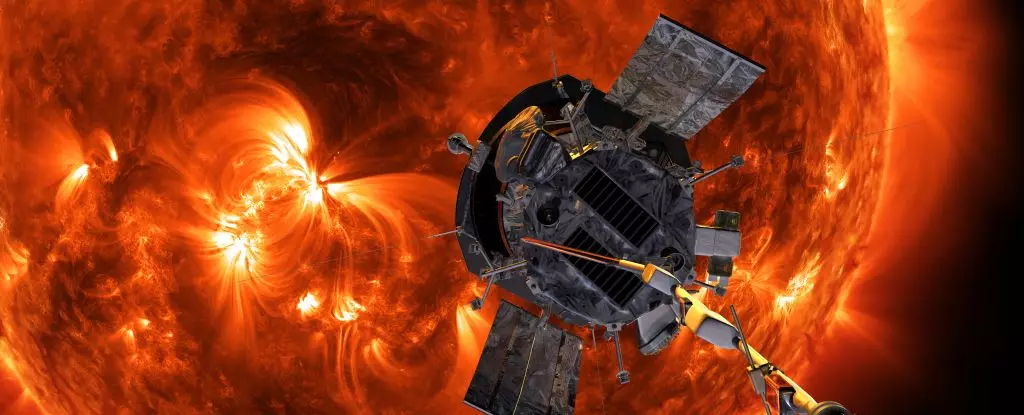NASA’s Parker Solar Probe is on the brink of another groundbreaking achievement as it approaches the Sun on Christmas Eve. The probe is set to break the record for both the closest and fastest human-made object to ever travel near the Sun. In its 22nd flyby, scheduled for December 24th at 06:53 EST (11:53 UTC), Parker will skim an astonishing 6.1 million kilometers (3.8 million miles) from the Sun’s surface, all while racing at speeds of approximately 192 kilometers per second. This mission exemplifies NASA’s commitment to pushing the boundaries of space exploration, allowing humanity to gain insights into one of the universe’s most enigmatic bodies.
The Parker Solar Probe has been communicating with mission control, confirming that all systems are operational. This reassuring news sets a positive stage for its final series of close flybys, known as perihelions, leading up to the mission’s conclusion in 2025. As astronomer Arik Posner, program scientist for Parker, notes, these daring exploits represent a bold step forward in answering long-standing questions about the Sun and our Solar System.
Launched in 2018, the Parker Solar Probe was designed to approach the Sun more closely than any previous spacecraft, allowing researchers to gather unprecedented data on the solar atmosphere, or corona. One of the significant questions surrounding the Sun is the perplexing disparity between the temperature of the solar corona—extending over 8.3 million kilometers into space—and that of the photosphere, the visible outer layer of the Sun. Traditional models still cannot explain why the corona is significantly hotter.
Moreover, other unresolved issues, such as the generation of the Sun’s magnetic field and the mechanisms driving solar activity fluctuations, continue to intrigue scientists. By analyzing the solar corona and studying the Sun’s behavior up close, researchers hope Parker will bridge the gaps in our understanding of these phenomena. As project scientist Nour Raouafi articulated, the mission is often likened to a modern-day “Moon landing,” symbolizing human curiosity and ambition in space exploration.
The upcoming perihelion will serve as both a challenge and a testament to the capabilities of the Parker Solar Probe. As it embarks on this ambitious journey, it will gather not only essential data but also test the technological prowess honed by scientists and engineers for years. Following the December 24 flyby, a beacon tone will be transmitted on December 27 to demonstrate that the probe has successfully endured the extreme conditions near the Sun.
In 2025, Parker plans to conduct up to four additional perihelions at similar speeds and distances from the Sun: two planned for March 22 and June 19, and two more tentatively scheduled for September 15 and December 12. While the continued exploration is exciting, it also introduces the inevitable challenge of fuel exhaustion. Scientists acknowledge that the Parker Solar Probe will eventually run out of the propellant necessary for maintaining its trajectory and shielding its delicate instruments from solar radiation. When this occurs, it will meet its end in an explosive finale, a poetic conclusion to a mission that dared to venture further than any vehicle preceding it.
The Parker Solar Probe’s mission signifies not just technological achievement, but also humanity’s relentless search for knowledge. As aerospace engineer Nick Pinkine affirms, the probe will be returning data from territories that have remained uncharted by previous missions. These efforts highlight the bravery of researchers in tackling the Sun—a fundamental force influencing life on Earth and the dynamics of our Solar System.
As we prepare to receive data and insights from this groundbreaking operation, it is crucial to acknowledge the collaborative effort behind the Parker Solar Probe. Scientists from various backgrounds, institutions, and disciplines have contributed to make this mission an extravagant success. In essence, Parker represents a collective dream of understanding our Solar System and its star, an endeavor pursued with diligence, curiosity, and teamwork.
The Parker Solar Probe illustrates the heights humanity can reach through innovation and exploration. As it sets off on its daring dive closer to the Sun, the mission will not only extend our comprehension of the solar phenomena but also inspire generations to continue seeking answers to the universe’s mysteries. With each perihelion, Parker serves as a reminder of the wonders that await when we dare to imagine.


Leave a Reply